R-20: Difference between revisions
Pbc captain (talk | contribs) No edit summary |
Pbcjohnston (talk | contribs) Added captions |
||
| Line 2: | Line 2: | ||
[[File:R-12 with r-20.jpg|left|500px]] | [[File:R-12 with r-20.jpg|left|500px]] | ||
<div style="text-align: justify;"><span style="color:#00008B">A snapshot photo of the R-20 and [[R-12|'''R-12 (SS-89)''']] moored in Honolulu Harbor circa 1920. The submarine base in Pearl Harbor was just beginning construction in 1920 and only one pier was ready for use. Honolulu Harbor piers were used until the fledgling submarine base could be expanded to accommodate more vessels. The R-20 seen here is moored to the R-12, both subs were part of the flotilla of R-Class submarines ordered to Hawaii after WWI. The R-20 has been awarded the Battle "E" for proficiency and readiness. | |||
<small>Photo in the private collection of Ric Hedman</small> | |||
[[File:Red bar sub new.jpg]] | |||
[[File:R-12 with r-20 upclose1.jpg|left|500px]] | [[File:R-12 with r-20 upclose1.jpg|left|500px]] | ||
<div style="text-align: justify;"><span style="color:#00008B">A closeup of the photo above showing the R-20 crew on deck. Three crew from the R-20 are seated on the framework that protects the "SC Tube" type hydrophone from damage. To their right is a sailor climbing out of the R-12 torpedo room hatch. Various sailors, civilians and Chief Petty Officers can be seen on the dock. | |||
<small>Photo in the private collection of Ric Hedman</small> | |||
[[File:Red bar sub new.jpg]] | |||
[[File:R-12 with r-20 upclose2.jpg|left|500px]] | [[File:R-12 with r-20 upclose2.jpg|left|500px]] | ||
<div style="text-align: justify;"><span style="color:#00008B">Another closeup showing R-12 moored inboard of the R-20. Crew are on deck. Three crew from the R-20 are seen in the center of the image. The man just to the right of the Chief appears to not be wearing a jumper but dressed in just a sleeveless T-shirt. To the left in the image a lone sailor seems to be either looking into a suitcase or, perhaps, playing a portable wind-up gramophone. It is hard to tell due to lack of resolution in the image. | |||
<small>Photo in the private collection of Ric Hedman</small> | |||
[[File:Red bar sub new.jpg]] | |||
[[File:R-20 and r-16.jpg|left|500px]] | |||
<div style="text-align: justify;"><span style="color:#00008B">R-20 and the [[R-16|'''R-16 (SS-93)''']], to the right in the background, with the circle on her conning tower fairwater. Location is off Hawaii in the early 1920's. The photo was taken from the deck of the [[R-14|'''R-14 (SS-91)''']]. | |||
<small>Photo in the private collection of Ric Hedman</small> | |||
[[File:Red bar sub new.jpg]] | |||
[[File:R-20 operating.jpg|left|500px]] | [[File:R-20 operating.jpg|left|500px]] | ||
<div style="text-align: justify;"><span style="color:#00008B">R-20 underway, most likely, off the Territory of Hawaii early 1920's. The R-20 was in Hawaiian waters from June 25, 1919 until her departure for inactivation at Philadelphia on December 12, 1930. | |||
<small>Photo in the private collection of Ric Hedman</small> | |||
[[File:Red bar sub new.jpg]] | |||
[[File:R-20 operating upclose.jpg|left|500px]] | [[File:R-20 operating upclose.jpg|left|500px]] | ||
<div style="text-align: justify;"><span style="color:#00008B">A closeup of the photo above, showing details of the conning tower fairwater, bridge, and gun. Note shirtless crew members on the left in the photo. These boats had no air conditioning and were very hot inside in tropical climates. | |||
<small>Photo in the private collection of Ric Hedman</small> | |||
[[File:Red bar sub new.jpg]] | |||
[[File:R-20 Pearl with ASR.jpg|left|500px]] | |||
<div style="text-align: justify;"><span style="color:#00008B">R-20 is shown here at the finger piers at Submarine Base Pearl Harbor, 1924-1925. The minesweeper USS Seagull (AM-30) is moored behind her, with the submarine rescue vessel USS Widgeon (ASR-1) moored outboard. During this period Seagull was serving as a makeshift submarine tender, although she was never officially re-rated as one. | |||
<div style="text-align: justify;"><span style="color:#00008B"> | <small>U.S. Navy photo.</small> | ||
[[File:Red bar sub new.jpg]] | |||
[[File:R-20 post war two ladies.jpg|left|500px]] | |||
<div style="text-align: justify;"><span style="color:#00008B">In order to abide by the restrictions of London Naval Treaty, the R-20 was decommissioned on 15 May 1931 and was put in mothballs at League Island at the Philadelphia Navy Yard. Ten years later, with the threat of a new war looming, she was selected to be returned to service and on 22 January 1941 she was recommissioned. In April 1941, after completing her fitting out, she shifted her base of operations to New London, Connecticut where she trained personnel and conducted patrols until June. She then shifted her homeport to Key West, Florida, arriving on 22 June 1941. She spent the remainder of her career there as a training ship for the Navy’s sound school, in addition to running anti U-boat patrols in the Straits of Florida, Gulf of Mexico, and the Bahamas. In the company of several others of her class, she provided great service until the end of the war. | |||
The R-20 was decommissioned at Key West 27 September 1945 and was struck from the Navy list the following month. On 13 March 1946, she was sold to Macey O. Scott of Miami, Fla. We know little about Mr. Scott, but we do know that he purchased several of the Key West based R-boats, ostensibly for scrap. | |||
In this photo two young women are posing alongside the ex-R-20. Scott apparently spent several months displaying the boats to the public in the Miami area, in an attempt to make some additional cash before he had to scrap them. The boat looks to be some sort of exhibit, and it is also likely that no one was allowed aboard for safety reasons since the Navy had probably stripped the interior of any useful equipment during the decommissioning process. The printing on the hull was intended to give visitors some idea of the arrangement of the boat from the outside. We are guessing that based on the writing on the submarine that she is still in the Miami area with the “Se Habla Espanol” for the Cuban and Puerto Rican residents of the area. The women’s clothing seems to support a 1946 or 1947 timeframe. It is likely that Scott was not able to display the boats this way for very long, as the contract he signed with the government likely stipulating that he cut them up for scrap. | |||
There is a second submarine on the right side of the photo and just the hint of a third, just above the “S” in “U.S.” and just to the right of the deck stanchion is the tip of a periscope from another submarine, likely one of the R-20’s R-class sisters. | |||
<small>Photo in the private collection of Ric Hedman</small> | <small>Photo in the private collection of Ric Hedman</small> | ||
[[File:Red bar sub new.jpg]] | |||
[[File:Red bar sub new.jpg]] | [[File:Red bar sub new.jpg]] | ||
Revision as of 12:28, 28 September 2023
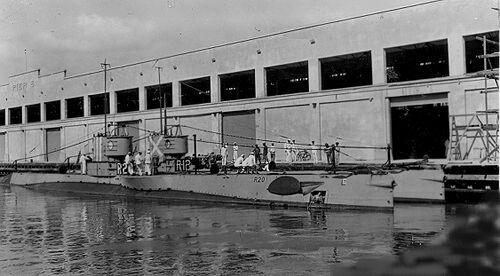
Photo in the private collection of Ric Hedman
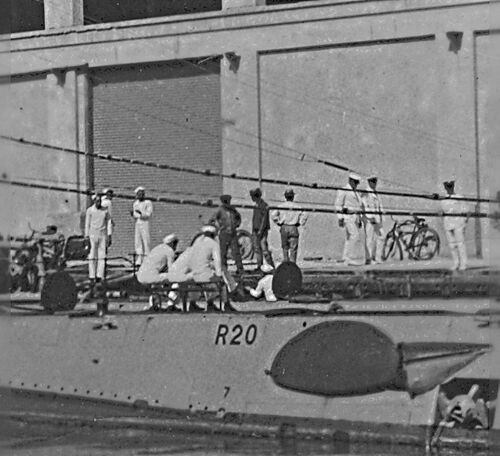
Photo in the private collection of Ric Hedman
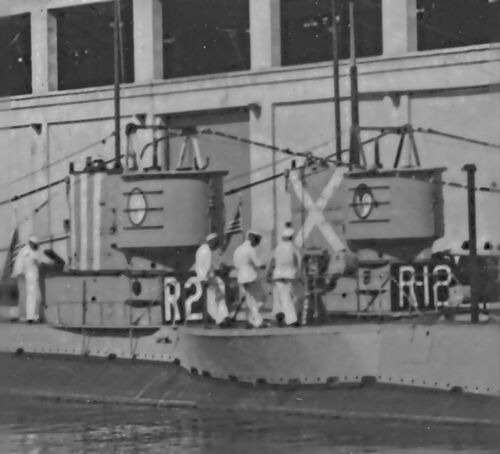
Photo in the private collection of Ric Hedman

Photo in the private collection of Ric Hedman
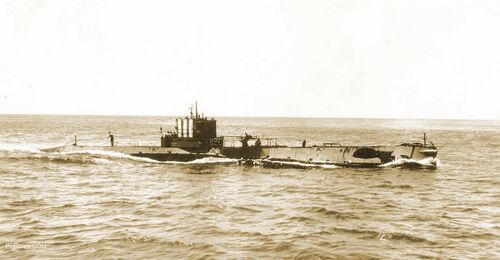
Photo in the private collection of Ric Hedman
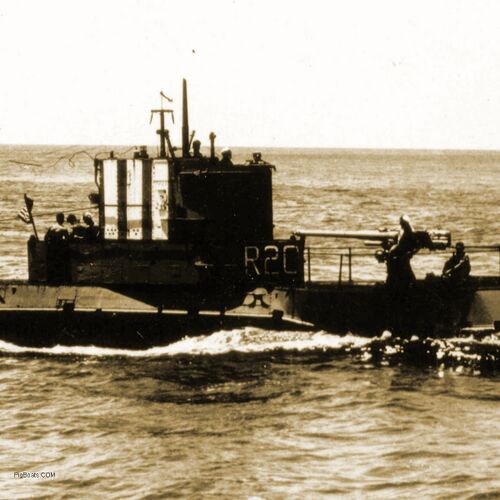
Photo in the private collection of Ric Hedman
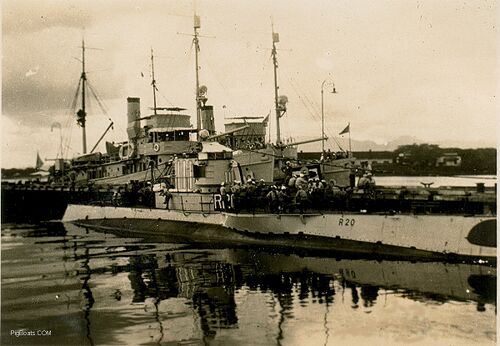
U.S. Navy photo.

The R-20 was decommissioned at Key West 27 September 1945 and was struck from the Navy list the following month. On 13 March 1946, she was sold to Macey O. Scott of Miami, Fla. We know little about Mr. Scott, but we do know that he purchased several of the Key West based R-boats, ostensibly for scrap.
In this photo two young women are posing alongside the ex-R-20. Scott apparently spent several months displaying the boats to the public in the Miami area, in an attempt to make some additional cash before he had to scrap them. The boat looks to be some sort of exhibit, and it is also likely that no one was allowed aboard for safety reasons since the Navy had probably stripped the interior of any useful equipment during the decommissioning process. The printing on the hull was intended to give visitors some idea of the arrangement of the boat from the outside. We are guessing that based on the writing on the submarine that she is still in the Miami area with the “Se Habla Espanol” for the Cuban and Puerto Rican residents of the area. The women’s clothing seems to support a 1946 or 1947 timeframe. It is likely that Scott was not able to display the boats this way for very long, as the contract he signed with the government likely stipulating that he cut them up for scrap.
There is a second submarine on the right side of the photo and just the hint of a third, just above the “S” in “U.S.” and just to the right of the deck stanchion is the tip of a periscope from another submarine, likely one of the R-20’s R-class sisters.
Photo in the private collection of Ric Hedman
Page created by:
Ric Hedman & David Johnston
1999 - 2023 - PigBoats.COM©
Mountlake Terrace, WA, Norfolk, VA
webmaster at pigboats dot com
